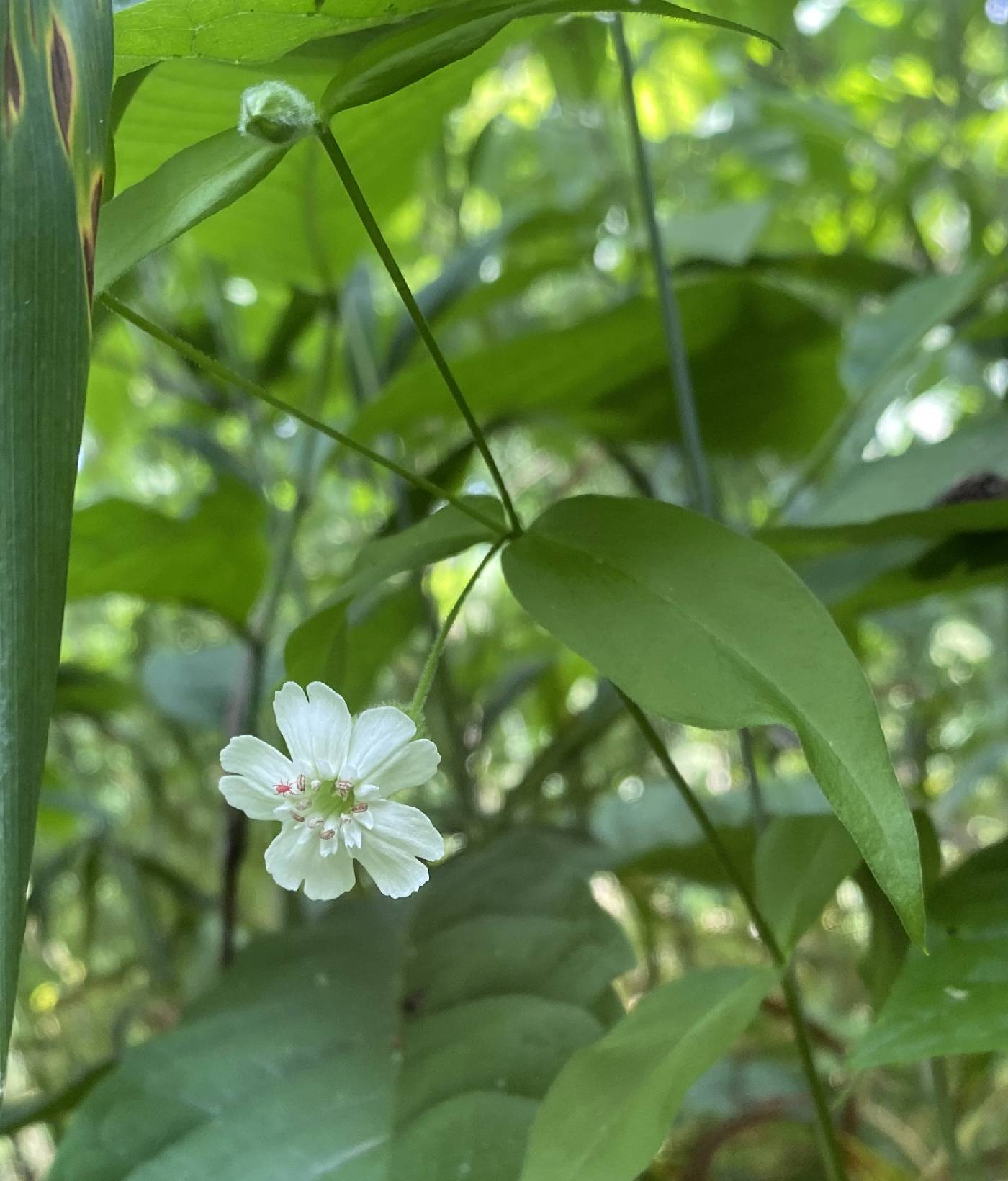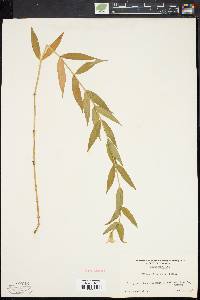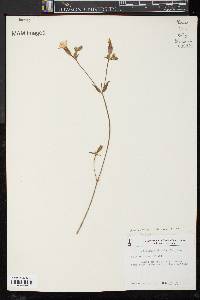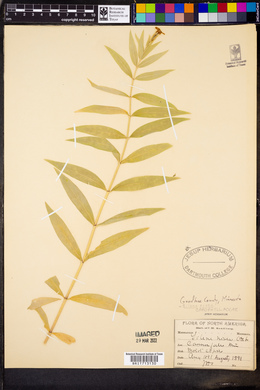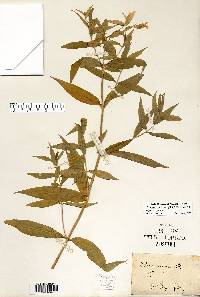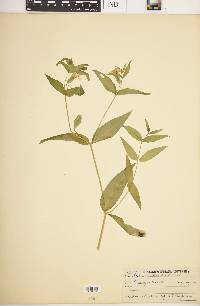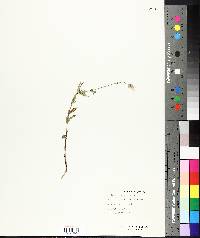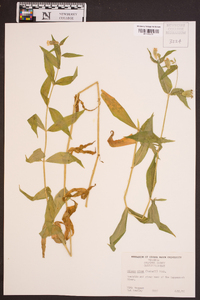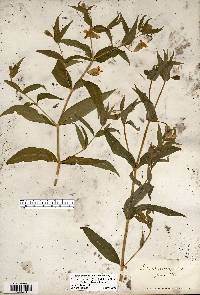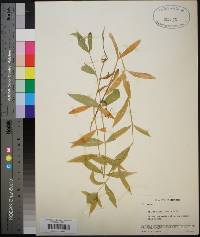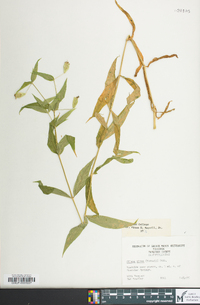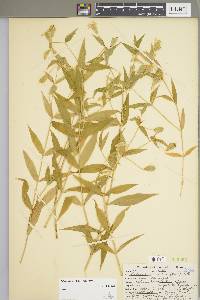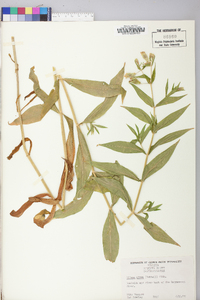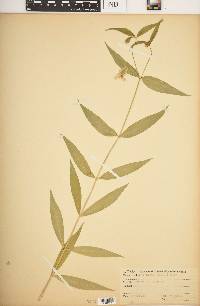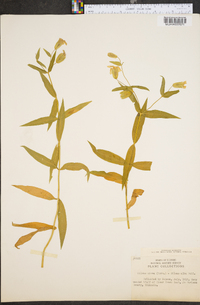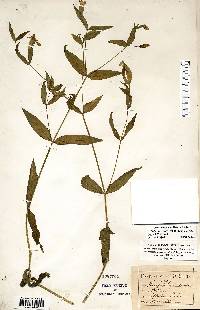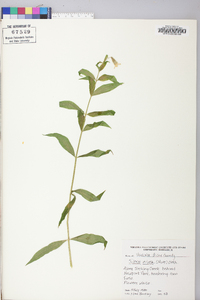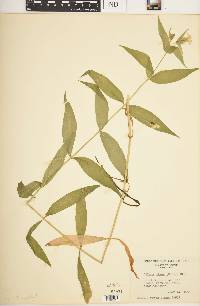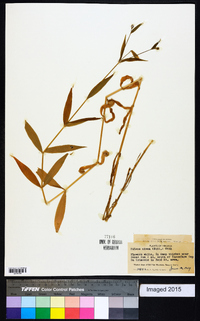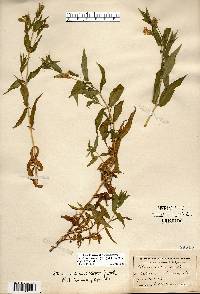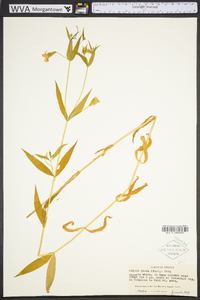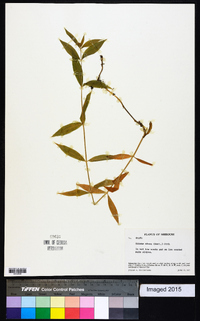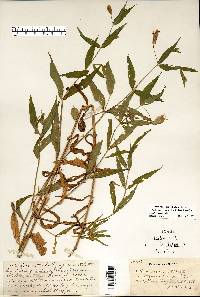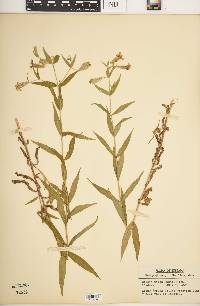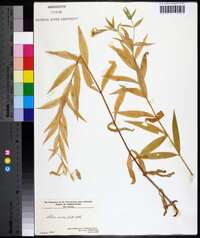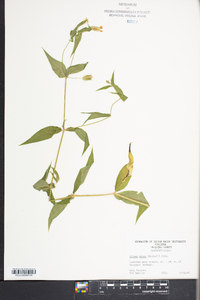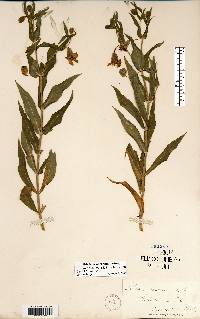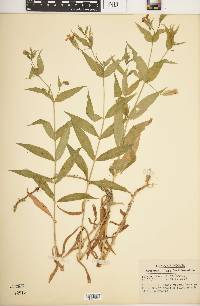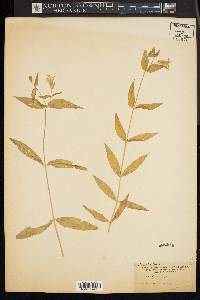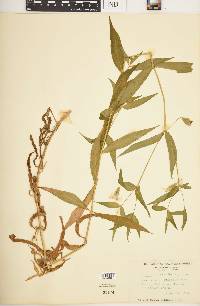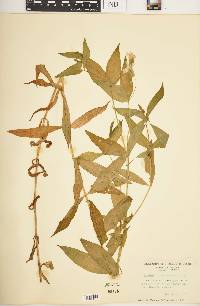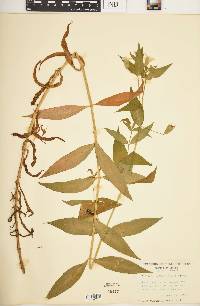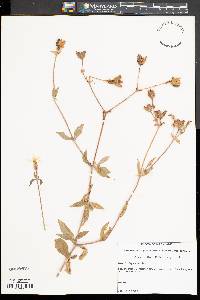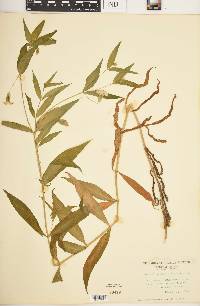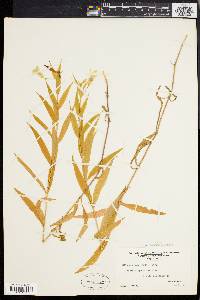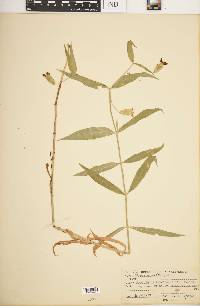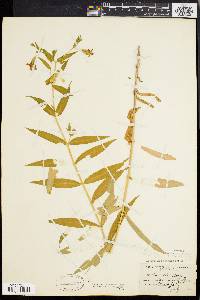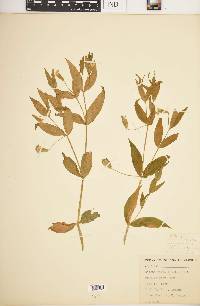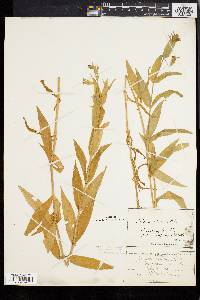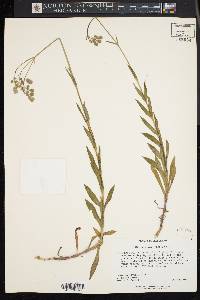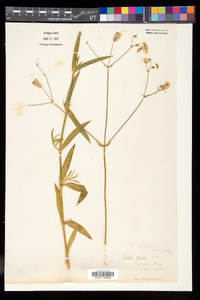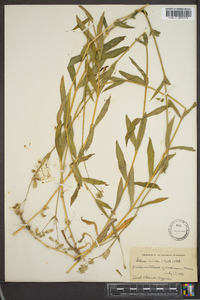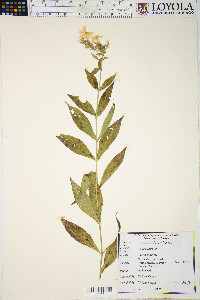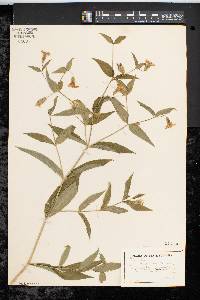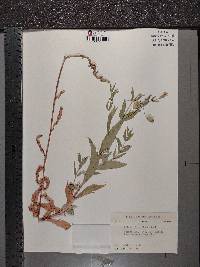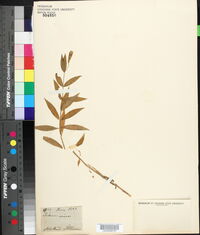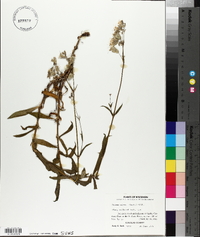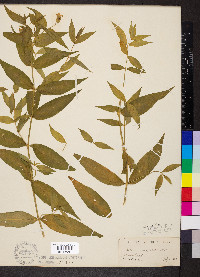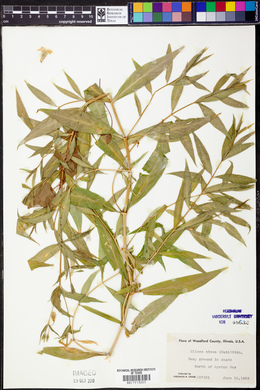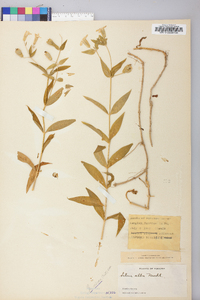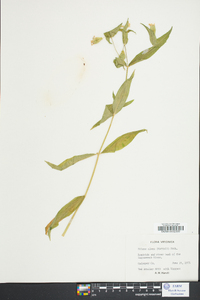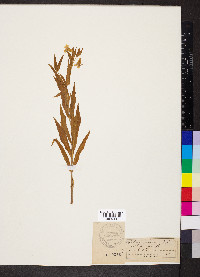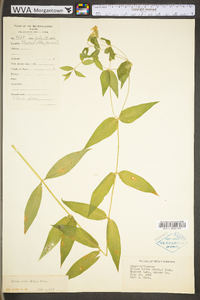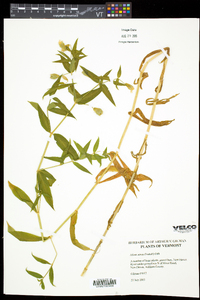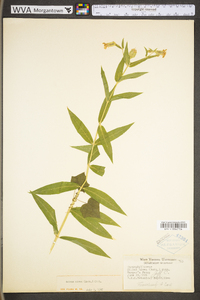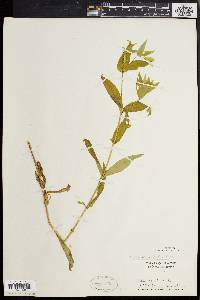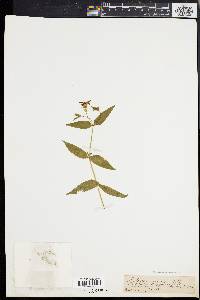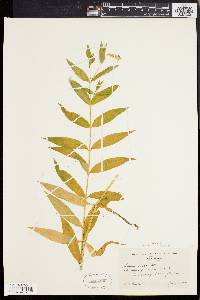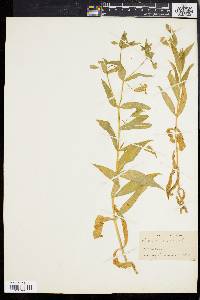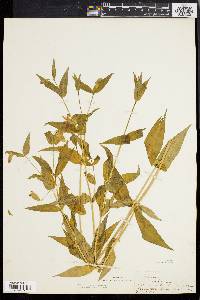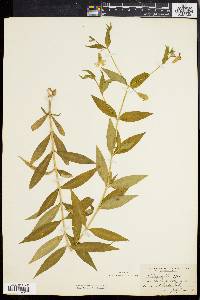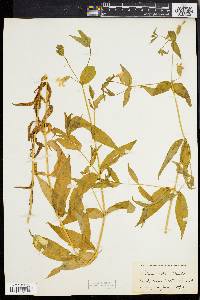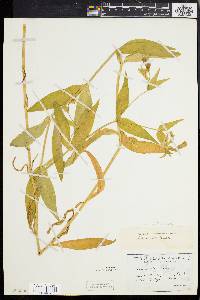Silene nivea
|
|
|
|
Family: Caryophyllaceae
Snowy Catchfly
[Silene nivea var. lancifolia Torr. & A. Gray] |
Plants perennial, rhizomatous; rhizome elongate. Stems erect, simple to sparingly branched, leafy, 20-70 cm, glabrous to puberulent, especially distally. Leaves 2 per node, sessile or short-petiolate, largest near mid-stem region, reduced and withering proximally, blade elliptic-lanceolate, base cuneate or rounded, apex gradually acuminate and acute, glabrous to puberulent. Inflorescences cymose, (1-)3-5(-12)-flowered, open, leafy. Pedicels 2-2 2 times calyx, apex often becoming deflexed, glabrous to hirsute. Flowers: calyx green, obscurely 10-veined, broadly tubular to campanulate, ± constricted at base around carpophore with broad umbilicate base, becoming broadly clavate in fruit, 14-17 × 5-9 mm, herbaceous, glabrous or hirsute, veins green, without pale commissures, lobes triangular, 2-3 mm; corolla white, clawed, claw equaling calyx, expanded distally into 2-lobed limb, limb oblong, 6-7 mm, appendages oblong, 1-1.6 mm, margins ± entire; stamens short-exserted; stigmas 3, short-exserted. Capsules globose, equaling calyx, opening by 3 broad teeth that sometimes split to form 6; carpophore 5-6 mm. Seeds dark brown to black, with grayish bloom, broadly reniform, not winged, 0.7-1 mm, sides with concentric crescents of low tubercles, larger and deeper on outer margins. 2n = 48. Flowering late spring-summer. Alluvial woodlands; 0-400 m; D.C., Ill., Ind., Iowa, Maine, Md., Mass., Minn., Mo., Ohio, Pa., Va., W.Va., Wis. The green, obscurely veined, umbilicate calyx with its broad base constricted around the carpophore is unique among the North American members of the genus. Silene nivea is occasionally weedy. It was introduced near Québec City (ca. 1969) but did not persist, and probably is not native also in Maine.
Perennial herb with an elongate rhizome 20 cm - 0.7 m tall Stem: upright, unbranched to sparsely branched, leafy, sometimes minutely hairy. Leaves: opposite, two per node, stalkless or short-stalked, 5 - 10 cm long, 1 - 3.5 cm wide, largest near middle of stem, smaller and withering toward base, elliptic to lance-shaped with a tapering or rounded base and long-pointed tip, sometimes minutely hairy. Inflorescence: a leafy, open cluster (cyme) of typically three to five flowers subtended by bracts. Flowers: white. Stalk upright, apex often bending downward, sometimes hairy. Stamens ten. Styles three. Sepals: fused at the base into a tube (calyx), green. Calyx tube about 1.5 cm long, 5 - 9 mm wide, broadly tubular to bell-shaped, indented at the base (umbilicate), obscurely ten-veined, sometimes hairy, with five short lobes. Lobes 2 - 3 mm long, and triangular. Petals: five, white, blade to 8 mm long, clawed, two-lobed. Fruit: a dehiscent capsule, one-chambered, opening by three (sometimes appearing as six) broad teeth, equal to calyx, spherical. Seeds brownish black with grayish bloom, to 1 mm long, broadly kidney-shaped, roughened. Similar species: No information at this time. Flowering: mid-June to mid-August Habitat and ecology: Rare in the Chicago Region, found in wooded ravines and on moist stream banks. It is also found in calcareous fens. Occurence in the Chicago region: native Etymology: Silene probably comes from the Greek word sialon, meaning saliva, referring to the sticky secretion on many of these plants. It may also have come from the word seilenos, referable to Silenus-a foam-covered, drunken character in Greek Mythology. Nivea means "snow white." Author: The Morton Arboretum Rhizomatous perennial, 2-3 dm, glabrous or puberulent; lvs mainly or wholly cauline, sessile or short-petiolate, lanceolate or lance-oblong, 5-10 נ1-3.5 cm, long-acuminate; fls few, mostly axillary; cal tubular-campanulate, 1.5 cm, umbilicate, glabrous or hirsute; pet white, without auricles, the appendages oblong, 1-1.6 mm, entire or erose, the blade cuneate, 8 mm, 2-lobed or 2-cleft; styles 3; fr unilocular, opening by 6 teeth; 2n=48. Woods; N.J., Pa., Md., and Va. to Tenn., Minn., S.D., Neb., and Mo. June, July. (S. alba Muhl.) Gleason, Henry A. & Cronquist, Arthur J. 1991. Manual of vascular plants of northeastern United States and adjacent Canada. lxxv + 910 pp. ©The New York Botanical Garden. All rights reserved. Used by permission. From Flora of Indiana (1940) by Charles C. Deam An infrequent to rare plant probably throughout the southern two thirds of the state. There are several published records but these nearly all coincide with the distribution shown on the map. Its habitat is wooded ravines and wooded banks of streams. …… Indiana Coefficient of Conservatism: C = 7 Wetland Indicator Status: FACW |

